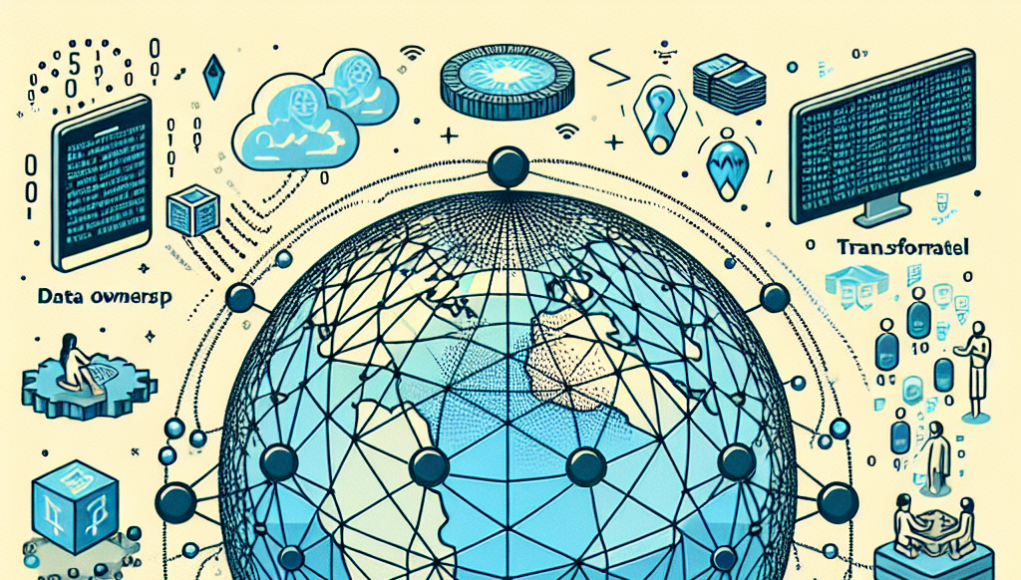As the digital landscape continues to evolve, the conversation around Web3 has gained significant momentum. Often hailed as the next evolution of the internet, Web3 promises a decentralized framework, offering new possibilities for digital interactions and data ownership. This article delves into the foundational aspects of Web3 technology, explores the critical role of blockchain in its development, and examines how Web3 is poised to transform our digital experiences.
Understanding the Basics of Web3 Technology
Web3, short for Web 3.0, represents a paradigm shift from the current internet model, which relies heavily on centralized platforms and services. At its core, Web3 envisions an internet where users have greater control over their data and digital identities. This shift is facilitated by decentralized technologies, which aim to redistribute power from large corporations to individual users. Unlike Web 2.0, where data is predominantly stored in centralized servers, Web3 leverages peer-to-peer networks, ensuring that data is distributed across multiple nodes, enhancing both security and privacy.
The architecture of Web3 is built upon several key technologies, including blockchain, decentralized applications (dApps), and smart contracts. Blockchain serves as the backbone, providing a secure and immutable ledger for recording transactions and data. Decentralized applications operate on peer-to-peer networks instead of centralized servers, allowing for more transparent and trustless interactions. Smart contracts, which are self-executing contracts with the terms of the agreement directly written into code, automate processes and reduce the need for intermediaries.
One of the most significant promises of Web3 is its potential to democratize the internet. By removing intermediaries, Web3 can reduce costs, increase efficiency, and provide users with more direct control over their digital assets. This democratization extends to various sectors, including finance, supply chain, healthcare, and entertainment, where decentralized solutions can enhance transparency and accountability.
Web3 also introduces the concept of tokenization, allowing digital assets to be represented as tokens on a blockchain. These tokens can represent anything from currency to intellectual property, creating new economic models and opportunities. Tokenization enables the fractional ownership of assets, broadening access to investment opportunities that were previously limited to a select few.
Interoperability is another crucial aspect of Web3, as it aims to create a seamless experience across different platforms and networks. By enabling different blockchain networks to communicate and interact with each other, Web3 fosters a more cohesive ecosystem. This interoperability is essential for realizing the full potential of decentralized applications and services, ensuring that users can easily transition between different platforms without friction.
In summary, Web3 technology represents a fundamental shift in how we interact with the internet. By prioritizing decentralization, privacy, and user empowerment, Web3 has the potential to redefine digital interactions and create a more equitable online environment.
The Role of Blockchain in Web3 Development
Blockchain technology is the cornerstone of Web3, offering the infrastructure necessary for decentralization and trustless interactions. As a distributed ledger technology, blockchain ensures that data is securely recorded across multiple nodes in a network, making it tamper-proof and transparent. This decentralization of data storage and management is a critical component of Web3, as it eliminates the need for centralized authorities that have traditionally controlled access and distribution.
One of the primary roles of blockchain in Web3 is to enable peer-to-peer transactions without the need for intermediaries. By leveraging cryptographic principles, blockchain ensures that these transactions are secure and verifiable, fostering trust among participants. This decentralization reduces the reliance on traditional financial institutions and opens up new possibilities for financial inclusion, particularly in regions with limited access to banking services.
Smart contracts, which operate on blockchain networks, are another pivotal element in Web3 development. These self-executing contracts automate processes based on predefined conditions, reducing the need for manual intervention and minimizing the risk of errors. In the context of Web3, smart contracts facilitate seamless interactions between decentralized applications and users, enabling a wide range of use cases, from decentralized finance (DeFi) to supply chain management.
Blockchain also plays a crucial role in ensuring data privacy and security within the Web3 ecosystem. Unlike traditional systems where data is stored in centralized databases, blockchain enables users to have control over their data through cryptographic keys. This shift in data ownership empowers users to decide who can access their information, enhancing privacy and reducing the risk of data breaches.
Another significant contribution of blockchain to Web3 is the concept of decentralized identity. By leveraging blockchain, users can create self-sovereign identities that are not tied to any single platform or service provider. This decentralization of identity management allows users to maintain control over their personal information and reduces the risk of identity theft or misuse.
In conclusion, blockchain is a fundamental enabler of Web3, providing the infrastructure and tools necessary for a decentralized internet. Its role in facilitating secure, transparent, and trustless interactions is critical to the realization of Web3’s vision, paving the way for a more equitable and user-centric digital landscape.
How Web3 is Transforming Digital Interactions
Web3 is poised to revolutionize the way we interact with digital platforms, offering a more decentralized and user-focused experience. One of the most significant transformations brought about by Web3 is the shift from platform-centric models to user-centric models. In the current Web 2.0 environment, users are primarily consumers of content and services provided by centralized platforms. In contrast, Web3 empowers users to become active participants and co-creators in the digital ecosystem.
Decentralized applications, or dApps, are at the forefront of this transformation, offering a wide range of services that operate on peer-to-peer networks. These applications eliminate the need for intermediaries, allowing users to interact directly with each other. This direct interaction reduces costs, increases efficiency, and enhances transparency, as users can verify transactions and data without relying on a central authority.
Web3 also introduces new economic models through the use of tokens and cryptocurrencies. These digital assets enable new forms of value exchange and incentivize user participation in decentralized networks. For example, users can earn tokens by contributing to a network, whether by providing computing power, creating content, or curating information. This token economy not only rewards users for their contributions but also aligns their interests with the overall success of the network.
Another area where Web3 is transforming digital interactions is in data ownership and privacy. In the Web3 paradigm, users have control over their data and can decide how it is shared and monetized. This shift empowers users to take ownership of their digital identities and reduces the power of centralized platforms that have traditionally monetized user data without explicit consent. By leveraging blockchain and cryptographic principles, Web3 ensures that data is stored securely and accessed only by those with permission.
Interoperability is also a key factor in transforming digital interactions within the Web3 ecosystem. By enabling different blockchain networks and applications to communicate with each other, Web3 fosters a more cohesive and integrated digital experience. This interoperability allows users to move seamlessly between different platforms and services, enhancing convenience and accessibility.
In essence, Web3 is redefining digital interactions by prioritizing decentralization, user empowerment, and transparency. As this new paradigm continues to evolve, it holds the potential to create a more equitable and inclusive digital landscape, where users are active participants rather than passive consumers.
The advent of Web3 marks a significant milestone in the evolution of the internet, offering a decentralized and user-centric approach to digital interactions. By leveraging blockchain technology and fostering a more equitable distribution of power, Web3 has the potential to transform various aspects of our digital lives, from data ownership to economic participation. As we continue to explore the possibilities of this new paradigm, it is crucial to consider both the opportunities and challenges that lie ahead. Ultimately, Web3 represents a bold vision for the future of the internet, one that prioritizes user empowerment and transparency in an increasingly interconnected world.










